Illinois Counties
There are one hundred and two counties in Illinois. St. Clair County was the first county established in what is today Illinois. Most counties in Illinois were named after early American leaders, especially of the American Revolutionary War, as well as soldiers from the Battle of Tippecanoe and the War of 1812.Henry County, Illinois
Henry County Education, Geography, and History
Henry County is a county located in the state of Illinois. According to the 2010 census, it has a
population of 50,486. Henry County was created
on January 13, 1825.The county seat is Cambridge.
The county is named for Patrick Henry (1736-1799),
American Revolutionary War figure and first and sixth Governor of
Virginia.
Henry County is included in the Davenport-Moline-Rock Island, IA-IL Metropolitan Statistical Area
Etymology - Origin of Henry County Name
The County was named for Patrick Henry, a lawyer, orator and statesman of the Revolutionary period, a member of the Continental Congress, and Governor of Virginia.
Demographics:
County QuickFacts: CensusBureau Quick Facts
Henry County History
Henry County was created on January 13, 1825 (Laws, 1825, p. 94) and was formed from unorganized land (Fulton
County). County organization was completed in 1837. Attached to Schuyler County (1825-1831) then to Knox County
(1831-1837), some records may be found here during these dates. County organization was completed in 1837. Present area,
or parts of it, formerly included in: Attached to Knox County [Laws, 1831, p. 63] (1831-1837), Attached to Schuyler
County [Laws, 1825, p. 95] (1825-1831), Putnam County (1825-1831), JoDaviess County (1827-1831), Fulton County
(1823-1825), Pike County (1821-1823), Madison County (1812-1821) and St. Clair County (1801-1812).
The County was named for Patrick Henry, a lawyer, orator and statesman of the Revolutionary period, a member of the
Continental Congress, and Governor of Virginia. The County Seat is Cambridge . Prior County Seats was Richmond
(1837-1839), Geneseo- Temporarily appointed to house records (1839-1840), Morristown (1840-1843) and Cambridge
(1843-Present).
Geography: Land and Water
As reported by the Census Bureau, the county has a total area of 826 square miles (2,138 km2), of which, 823 square miles (2,132 km2) of it is land and 2 square miles (6 km2) of it (0.29%) is water.
Henry county is located in northwest Illinois. The county is the 29th largest of
Illinois' 102 counties. The area is fairly flat, with elevations ranging from 650 feet above sea level in the
northwest to 850 in the southeast. The land is mostly used for agriculture, about 456,596 acres (1,848 km2) or 86.7%
of the county's land area. Johnson-Sauk Trail State Park is located in this
county.
Neighboring Counties
Bordering counties are as follows:
- Northeast: Whiteside County
- East: Bureau County
- Southeast: Stark County
- South: Knox County
- Southwest: Mercer County
- Northwest: Rock Island County







